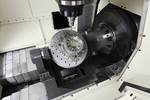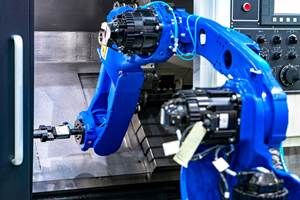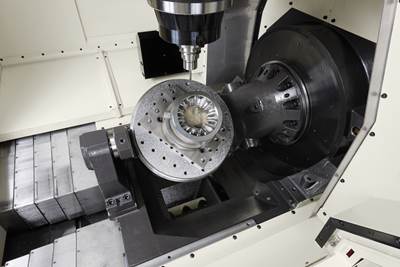KUKA Presents Industry Outlook to the Association for Advanced Automation
KUKA representatives discuss new industries driving the growth of automation, the increased demand for autonomous mobile robot platforms and showcase demonstrations.
On March 31, KUKA Robotics North America (Shelby Township, Mich., U.S.) Chief Regional Officer John Bubnikovich, Regional Head of Advanced Robotic Applications Denise Ebenhoech and Director of Medical Robotics Corey Ryan presented their automation industry insights and outlooks to the Association for Advanced Automation (A3) during its Automate Forward trade show and conference. During the virtual event, which took place March 22-26, 2021, Bubnikovich discussed new industries driving the growth of automation, Ebenhoech explained the increasing demand for autonomous mobile robot platforms and Ryan showcased the growing use of collaborative robots in medical procedures.
According to Bubnikovich, the world is moving towards greater adoption of automation and robotic solutions. In addition to established industries such as automotive and electronics, significant growth opportunities continue to emerge, particularly within the food and beverage, metal and plastics production sectors. He added that there is also a growing demand for increased robotic capabilities such as bin picking and smart solutions that could help companies further reduce their overall carbon footprints as they look to reduce waste within supply chains and increase their energy efficiency.
Within today’s competitive global marketplace, there is growing demand for more personalized and varied products, and manufacturers must seek creative ways to overcome space limitations and other complex production challenges.
Bubnikovich explored how, as industries continue to evolve and fully accept automation, it will be critical that they use these capabilities to keep internal operations flexible so they can adapt to constantly shifting demands. As machine intelligence revolutionizes factory automation, industries will continue to move toward developing smart production facilities with an emphasis on flexible autonomous mobile robots/platforms; real-time, cloud-connected data; and remote diagnostics and support. A greater number of smaller manufacturers will become first-time adopters, especially of collaborative robots (cobots) and turnkey automation solutions.
In her presentation, Ebenhoech returned to the subject of autonomous mobile platforms, describing how they have increasingly incorporated robot arms to provide flexibility and support for more applications. Within today’s competitive global marketplace, she said, there is growing demand for more personalized and varied products, and manufacturers must seek creative ways to overcome space limitations and other complex production challenges. To do so, many have turned to autonomous mobile platforms equipped with not only integrated robot arms, but also omnidirectional wheels, intelligent software and sensors that allow them to safely navigate factory floors. Ebenhoech highlighted how these sophisticated vehicles combine the strengths of all of these technologies to perform a number of complicated tasks throughout a company’s operations.
As with autonomous mobile platforms, collaborative robots continue to garner much attention. During his presentation at Automate Forward, Ryan indicated that the number of collaborative human-robot applications has increased significantly over the past few years. He also pointed out one often overlooked application, in particular, where these robots are playing a much larger role—medical procedures. One of the most promising of these applications is AOT AG’s (Advanced Osteotomy Tools, Basel, Switzerland) CARLO (Cold Ablation Robot-guided Laser Osteotome), which uses a KUKA LBR Med cobot to support the system and enable surgeons to perform contactless bone surgery with a laser.
To illustrate the capabilities of this advanced solution, Ryan walked event attendees through every part of the CARLO system, from the navigation and control software, to the cobot and corresponding hardware. In addition to discussing the safety considerations and precautions built into the system to protect the surgeon and patient, Ryan examined the health benefits of using robot-guided laser osteome versus traditional medical procedures.
Related Content
Mold Builder Meets Increased Domestic Demand With Automated Cells
Burteck LLC experienced significant demand increases due to reshoring and invested in automated machining cells to step up its production output quickly and avoid losing business.
Read MoreMachine Hammer Peening Automates Mold Polishing
A polishing automation solution eliminates hand work, accelerates milling operations and controls surface geometries.
Read MoreHow to Start Automating Your Moldmaking Operation
A few fundamentals of moldmaking automation include identifying key areas and places to avoid and addressing common concerns and roadblocks.
Read MoreDevelopments in High-Speed Machining Technology
There have been many exciting developments in high-speed machining relative to machining centers and controls, tooling and CAD/CAM systems.
Read MoreRead Next
The Association for Advancing Automation: The Voice of Automation
The biggest challenge is to be the voice of automation and educate potential users about the benefits of automating—especially small- to medium-size companies who may feel automation is out of their realm.
Read MoreThree Good Reasons to Switch from Three- to Five-Axis Machining in Moldmaking
Five-axis machining technology is a great tool in the moldmaker toolbox.
Read MoreHow to Use Strategic Planning Tools, Data to Manage the Human Side of Business
Q&A with Marion Wells, MMT EAB member and founder of Human Asset Management.
Read More


























